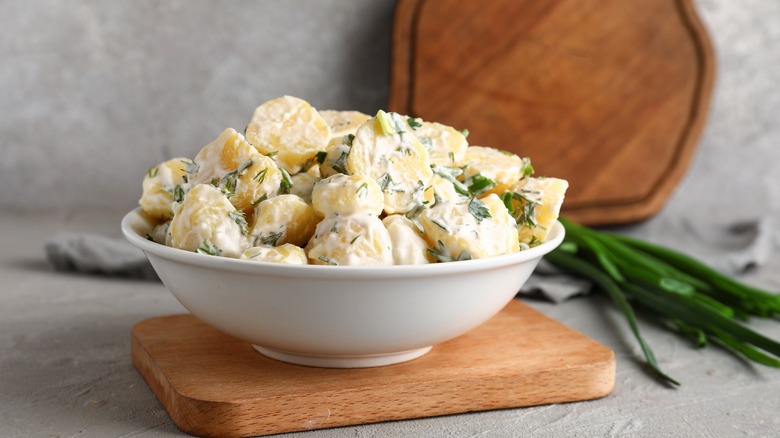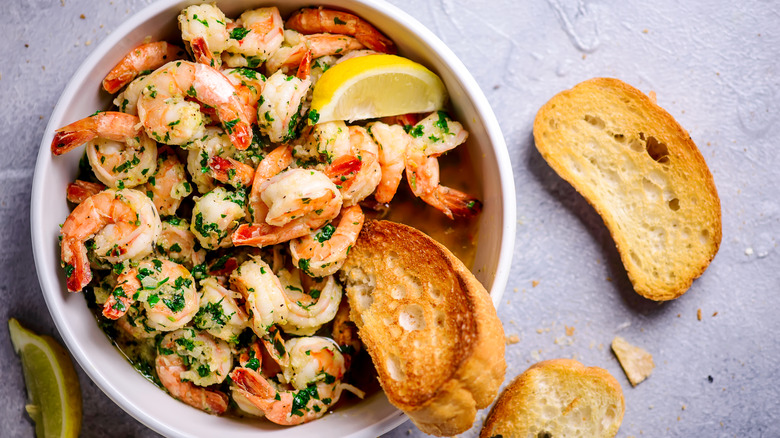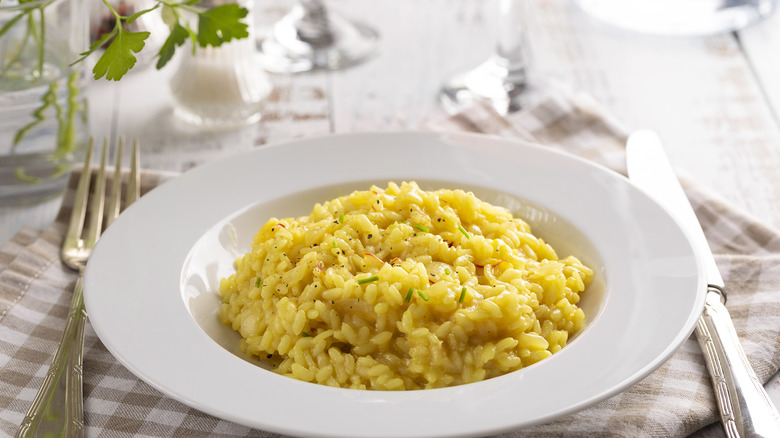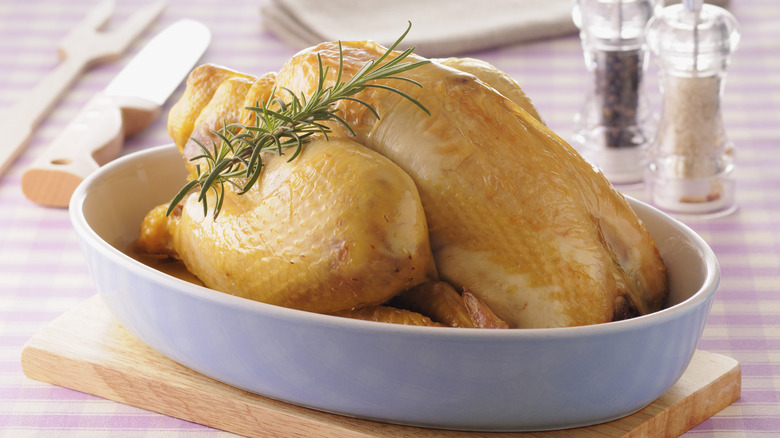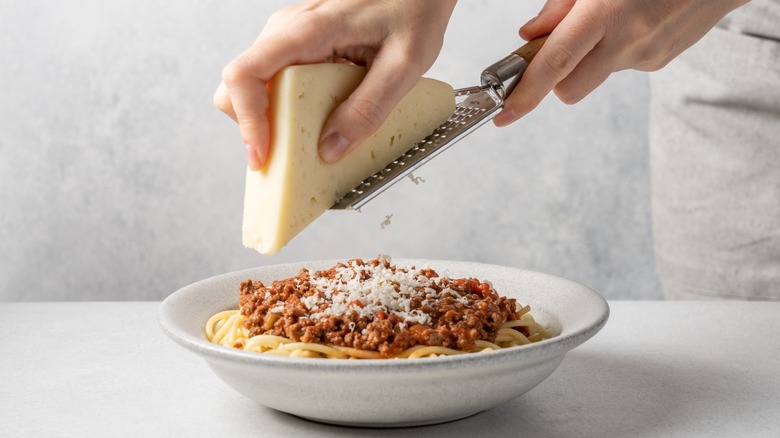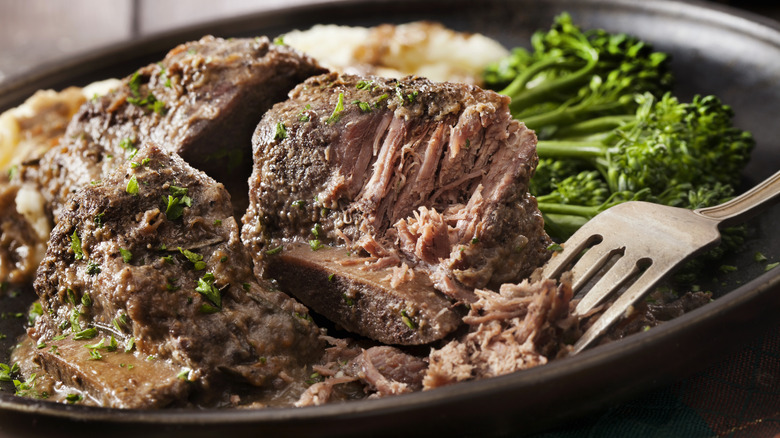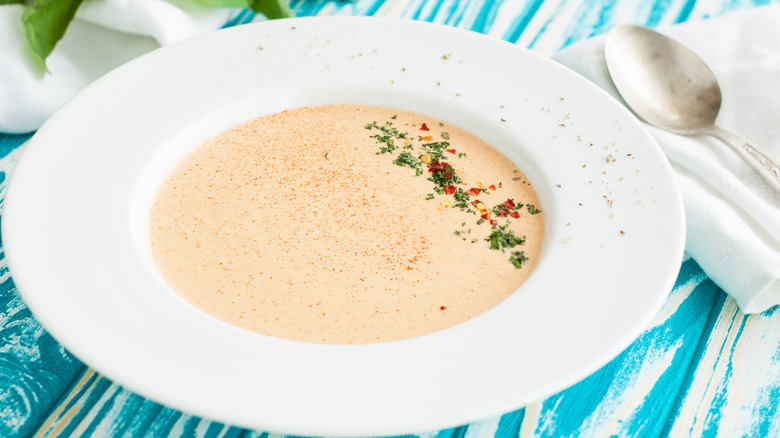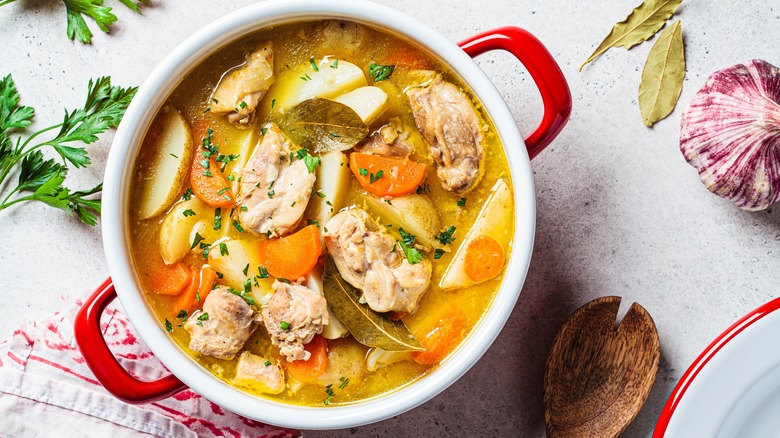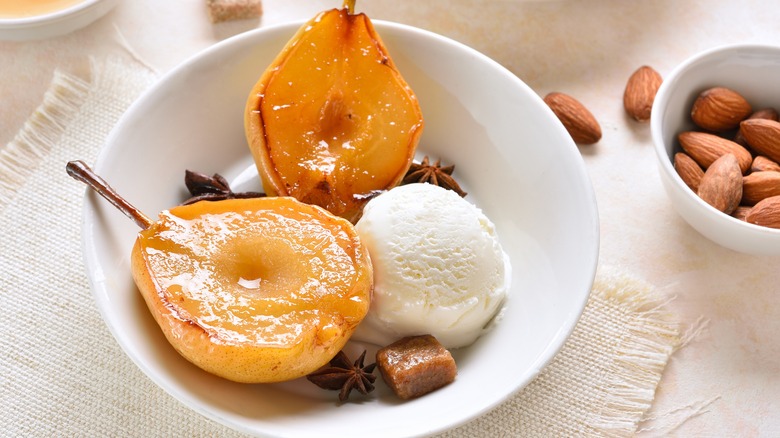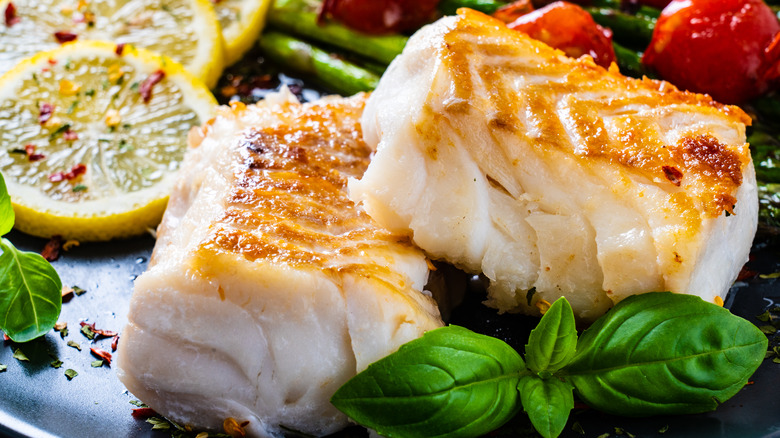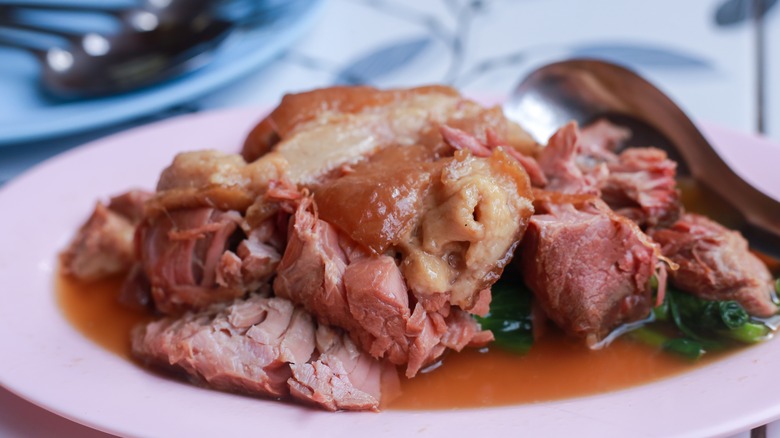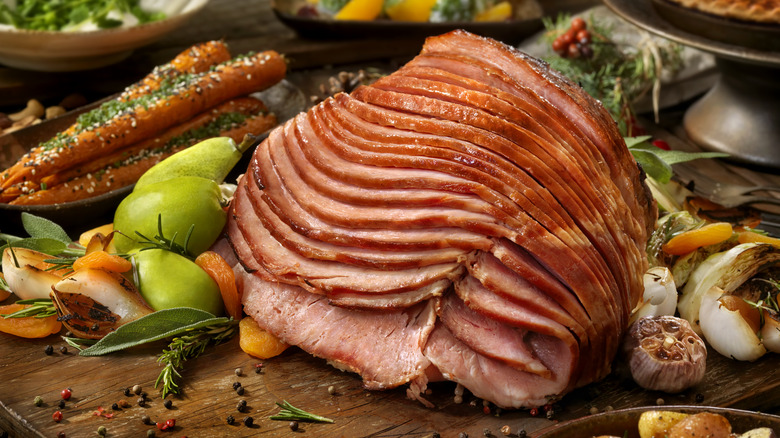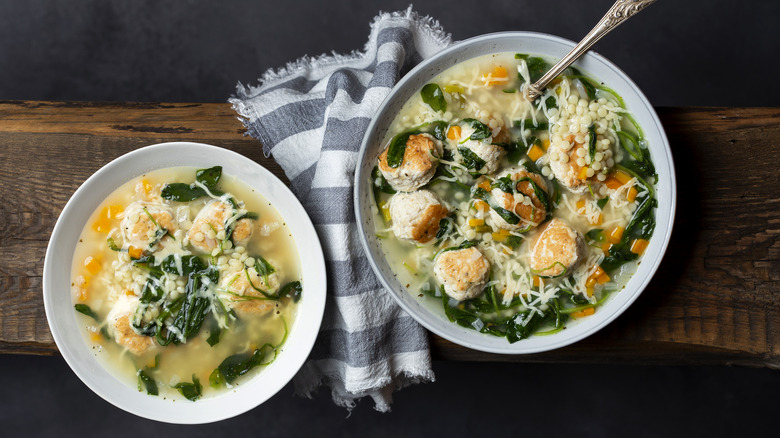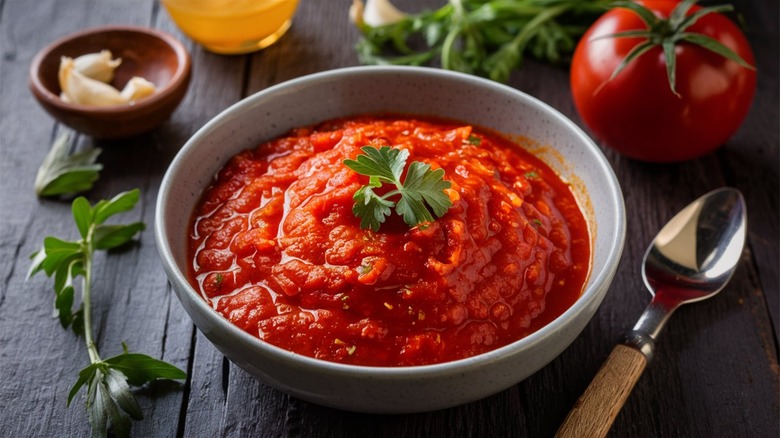Ina Garten's Favorite Ways To Cook With Wine
We may receive a commission on purchases made from links.
Celebrity chef Ina Garten is known for many things, including her approachable recipes, her storied Hamptons shop known as the Barefoot Contessa (which is also her moniker), and the enticing way in which she makes cocktails. Of course, while Garten prepares mixed drinks with genuine gusto, she's also a great lover of wine. Her favorite type of French wine is Burgundy, which she prefers over Bordeaux, as it's lighter and fruitier. Additionally, Garten has previously said her favorite rosé is Vin Gris from Sinskey Vineyards in California.
But the Food Network star doesn't just love wine as a beverage. She's been known to use wine in a wide range of dishes, even putting it into the food itself on occasion. There's no shortage of recipes where she incorporates wine, in fact, including the use of an entire bottle of red wine when making braised short ribs (though that's not the only dish where the Barefoot Contessa adds copious amounts of wine). Let's take a look at some of the other delicious ways she uses this delightful ingredient. Here are Ina Garten's favorite ways to cook with wine.
Splash it into a potato salad
The success of a potato salad is mostly determined by the dressing used to flavor those potatoes, which generally consist of two different types of tubers (about six of each kind). This is why Ina Garten likes to add a splash of white wine to her French potato salad, which she feels imparts a lot of additional flavor into the dish. Along with white wine, Garten also adds a bit of chicken stock and some seasoning to the potatoes — all of which serves to form the base before she even adds the actual dressing portion.
The key is adding the 2 tablespoons of wine while the potatoes are still warm. This allows the juices to properly soak in, and ensures the taters are primed for their dressing. Garten makes her salad dressing with Champagne vinegar (incidentally, also a derivative of wine), olive oil, and Dijon mustard. She finally tops it all off with fresh herbs, like basil and dill, to complete the flavor profile.
Tip wine into baked shrimp scampi
Whenever you're planning on making a fish dish, it's never a bad idea to have some dry white wine on hand. The liquid just seems to bring out the best in virtually any type of seafood, after all. This is certainly true with one of Ina Garten's go-to comfort dishes: baked shrimp scampi. Her secret is to let the shrimp marinate in the white wine mixture for at least a few minutes while you put together the rest of the recipe. This gives the ingredients time to blend together, as well as allowing the acidity of the wine to penetrate the shrimp.
Garten adds 2 tablespoons of dry white wine along with garlic, chili flakes, lemon, and butter. If you're using a good wine, be sure to save some for the actual meal, and serve it alongside the dish. The acidity of the wine (both in the recipe and in your glass) will help to undercut some of the richness of the copious amounts of butter this recipe calls for.
Use it in risotto
Ina Garten didn't come up with the idea of adding white wine to risotto. In fact, most risotto recipes call for this ingredient — and yes: it's important to use white wine rather than red, or you'll end up with an unappetizing mound of gray mush. Still, it probably didn't take much to convince Garten to adopt this strategy when cooking risotto herself.
In particular, Garten uses white wine in her saffron risotto with butternut squash. After toasting the rice (but before the stock goes in), she adds ½ cup of wine to the pot. Other useful tips include roasting the squash in the oven (instead of boiling it) before chopping and adding to the rice, as this gives the entire dish more flavor.
If you're worried about making risotto for the first time (which can seem like a daunting task), remember that all you have to do is add the stock slowly over time rather than all at once. This may be more labor intensive, but it'll yield a perfectly textured risotto — the way the Italians intended.
Baste roasted chicken with wine
When roasting a whole chicken, it's important to baste it regularly with liquid to keep it moist. And, according to Ina Garten, that liquid should contain wine. In fact, Garten's skillet roasted lemon chicken recipe calls for a splash of white wine during the cooking process. The addition of wine helps turn the juices from the chicken into a sauce, which can be drizzled over the rest of the meal, including mashed potatoes or roasted vegetables.
Along with wine, Garten generally roasts chicken with some thyme, fennel seed oil, onions, and plenty of lemon. This dish is ideal for dinner parties, as most of the work (aside from the basting) is done before the chicken goes into the oven. Given this, you can sit back and relax while you wait for the poultry to cook — or enjoy the rest of the bottle of wine you opened with your guests.
Stir it into a Bolognese
A classic Bolognese sauce doesn't necessarily require wine to be flavorful — but it certainly doesn't hurt to add it. Indeed, Ina Garten adds dry red wine to elevate her Bolognese sauce. But while this tactic is common in many Bolognese recipes, Garten takes it one step further, and reserves ¼ cup of that same red wine for the end of the recipe.
Garten pours this remaining bit of wine into the almost finished sauce, giving it a burst of acidity and brightness. Unlike the first dose of wine, this one doesn't have time to cook off the alcohol before the sauce is done. The flavor of the wine itself remains part of the overall taste as a result, which provides a bit of an edge to the dish. Garten finishes off her Bolognese recipe with heavy cream instead of the usual milk — a richness that pairs nicely with the added acidity from the extra wine.
Braise short ribs in red wine
The fact that the best recipe Ina Garten has ever written (according to herself, that is, as noted in her "Cook like a Pro" cookbook) is short ribs braised in red wine says a lot about the power of red wine. This is especially true since a lot of red wine is involved in this dish, with an entire bottle used for this feat.
Garten begins the process by roasting the ribs in the oven to give them a nice browning, then cooks them in a Dutch oven for two hours after soaking them in beef stock, red wine, and Irish stout beer. That last ingredient gives the meat a rich, malty flavor that combines with the red wine (make sure it's full-bodied) to create deep chocolatey notes. Since you'll use the whole bottle for the dish itself, be sure to grab another to serve alongside the finished ribs. These are deep, intense flavors, and a fine red wine will help round out the dish.
Slip cream sherry into lobster corn chowder
Cream sherry is a type of fortified wine mixed with sweeter wines, giving it an intensely sweet and nutty flavor — one that won't go unnoticed in any dish it's added to. One such dish is Ina Garten's lobster corn chowder. In this, she creates a broth with cream sherry, lobster juices, milk, and heavy cream, then lets it simmer into a creamy chowder full of depth.
The cream sherry is first added to the aforementioned broth, which serves as the foundation of the soup. But it also comes in as a finishing touch after all is said and done. Just before turning off the heat, add that last touch of cream sherry to make sure the flavor notes are really felt. Incidentally, Garten calls for 1 cup of dry white wine here, as well. Since sherry is used not once but twice in this recipe, the additional white wine makes this a particularly alcohol-forward dish.
Fortify a chicken pot pie soup
Another great way Ina Garten uses cream sherry wine is in her chicken pot pie soup. Again, Garten uses this somewhat unusual ingredient to fortify the base of the dish, which she makes by sauteing leeks, fennel, carrots, garlic, and tarragon, before adding flour, cream sherry, chicken stock, Parmesan rind, and seasoning. The sherry makes another appearance at the end of this recipe, right before serving.
Now, if you're wondering what makes this a chicken pot pie soup (and not just chicken soup), the puff pastry croutons seal the deal. But the cream sherry has a lot of say in the matter, as well. Its inclusion turns a run-of-the-mill family staple into a much more sophisticated version of soup. Given the combination of nuttiness, sweetness, and acidity that the cream sherry lends, the overall flavors end up more layered and dynamic. In other words, the cream sherry isn't just an afterthought in her chicken pot pie soup — it's a key component.
Poach pears with vin santo
Vin santo is not a typical ingredient you'll see in recipes — sweet or savory. Italian for "holy wine," it's a sweet dessert wine with caramel and hazelnut notes that's been used in the celebration of Catholic mass. Given the intense dessert aura of this wine, it makes sense that if Ina Garten were to use it at all (which she does), it would be in a dessert; and the dessert in question is her poached pears.
Garten simmers the pears in the sweet wine along with sugar, spices, lemon juice, and dried fruit, which the pears soak up like sponges. You can serve this dessert warm with whipped cream or vanilla ice cream, as the richness will be a nice foil to the acidic elements in the dish. You can also add a drizzle of melted dark chocolate over the pears, or follow the same recipe using another porous fruit as the star of your show, such as apples.
Add wine to fish dishes
Fish and white wine seem to go hand in hand, which is why it's no surprise that Ina Garten has a number of fish recipes that call for white wine. Among the most notable is her baked cod with garlic and herb crumbs, where a dry white wine (along with some lemon juice) is used to baste the fish halfway through cooking. This ensures it remains moist enough to allow the herb crumbs to stick to its surface.
Another standout recipe is Garten's summer skillet with clams, sausage, and corn. Here, the wine is added to a skillet along with plenty of butter, both of which serve to flavor the clams before they're placed on top of the mixture. The wine here gives the dish a pleasant bite while joining in with other strong flavors, such as sausages and tomatoes. Serve this dish hot with French bread, which you can dip into the wine sauce to enjoy even more of its flavor.
Complement pork with dry wine
When you roast meat slowly, it's important to keep it moist throughout the process. Otherwise, you run the risk of it becoming dry and chewy — and not the melt-in-your-mouth magic that's often the signature quality of such dishes. This may be why Ina Garten likes to add dry white wine to her pork roasts. Since wine is an acidic ingredient (that also happens to taste good and imparts flavor), it helps tenderize the meat in addition to keeping it moist.
To make this work, Garten pours 2 cups of wine into the pan with the prepared pork before covering it and cooking it. The wine slowly tenderizes the meat while it cooks for a few hours, at which point Garten adds even more wine to the pot to make sure the meat doesn't absorb all the liquid before it's done. By the end, you'll have a tender, tasty pork dish that will fall right off the bone.
Glaze ham with Port wine
Many of Ina Garten's recipes involving wine call for dry whites or dry reds. This makes sense, as the dryness of these wines won't interfere with the savory flavor of whatever dish it's being added to. But sometimes it's nice when wine can bring a touch of sweetness — hence Garten's use of Port wine when making certain types of ham (a type of meat that pairs quite well with a bit of sweetness).
Garten likes to use Port when making her orange marmalade glazed ham. Though the marmalade will certainly do some heavy lifting in the sugar department (as will the brown sugar and chutney), the ruby Port wine seems to drive home that flavor component. Plus, Port wine (which is included in the glaze) isn't just sweet, but also acidic. Consequently, it pulls double duty and tenderizes the meat, as well. Once cooked, Garten recommends serving this sweet meaty dish with some homemade buttermilk biscuits.
Fortify soup with it
Like most of us, Italians enjoy celebrating weddings with booze. But they like putting alcohol in their wedding food, as well — or that's what Ina Garten does when she makes Italian wedding soup. Her recipe for this traditional soup includes ½ cup of dry white wine, which is added to the broth itself rather than the actual meatballs.
Garten then cooks the wine with stock, sofrito, and pasta, but only for as long as it takes to cook the pasta (up to eight minutes). This is generally enough time to cook off most of the alcohol, as well, but not enough to cause its signature acidic bite to disappear completely. The result is a soup with a soft and forgiving flavor, as well as just enough acidity to brighten up the rest of the ingredients. If the bite isn't strong enough for you as the cooking comes to an end, no one will judge you for adding an extra splash of wine to finish it off. It is a wedding soup, after all.
Pour it into marinara sauce
The traditional version of marinara sauce is so popular in part because of its simplicity: It's made with nothing more than tomatoes, garlic, seasoning, and olive oil. But that doesn't mean it can't be spruced up with some extra flavor once in a while. That's just what Ina Garten likes to do when she adds a touch of red wine to her marinara sauce, after all. This gives the sauce a more full-bodied flavor, as long as you use a dry full-bodied wine, which Garten does (she uses Chianti).
The trick is to pour ½ cup of wine in at the very beginning — when you're sauteing the onions and garlic in olive oil — before adding the tomatoes. Be sure to briefly increase the heat at this point, as you'll want to cook off the alcohol while keeping the flavor. After all the ingredients have been incorporated, simmer the concoction for about 15 minutes to allow the flavors to blend together. Use it on anything you think will go well with marinara sauce, including pizza, pasta, and even grilled chicken.

